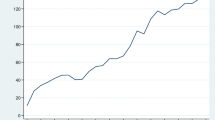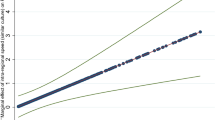Abstract
Recent international strategy research emphasizes the importance of understanding the effects of geographic location on firms’ strategies and performance outcomes. We contribute to this research by providing empirical evidence that the interplay of country and industry effects matters substantially in explaining the variation in the value of growth options of firms based in different countries. Our results show that country–industry effects are the second largest source of variation, following firm effects, while industry and country effects are relatively small when considered in their own right. That valuable growth options are tied to country and industry interactions has important implications for international strategy research and practice.
Similar content being viewed by others
Notes
For US firms, Compustat assigns a four-digit SIC classification to the firm's primary industry, which is determined by analyzing the sales breakdown reported in the firm's 10-K and annual reports. For international firms, Mergent Online relies on the reported primary SIC if the firm's ADR trades on US exchanges; otherwise, Mergent Online reviews the business descriptions provided by the firm and assigns it a primary four-digit SIC based upon the descriptions.
We thank an anonymous reviewer for this suggestion.
We thank an anonymous reviewer for this suggestion.
References
Alessandri, T. M., Lander, D. M., & Bettis, R. A. 2007. Strategic implications of valuation methods. Advances in Strategic Management, 24: 473–499.
Barro, R. J. 1997. Determinants of economic growth: A cross-country empirical study. Cambridge, MA: MIT Press.
Bartlett, C. A., & Ghoshal, S. 1989. Managing across borders: The transnational solution. Boston, MA: Harvard Business School Press.
Bowman, E. H., & Helfat, C. E. 2001. Does corporate strategy matter? Strategic Management Journal, 22 (1): 1–23.
Bowman, E. H., & Hurry, D. 1993. Strategy through the options lens: An integrated view of resource investments and the incremental-choice process. Academy of Management Review, 18 (4): 760–782.
Brealey, R. A., & Myers, S. C. 2000. Principles of corporate finance (6th ed.). Boston, MA: Irwin/McGraw-Hill.
Brouthers, L. E. 1998. Explaining MNC profitability: Country-specific, industry-specific, and country–industry interactive influences. Management International Review, 38 (4): 345–361.
Chang, S. -J., & Singh, H. 2000. Corporate and industry effects on business unit competitive position. Strategic Management Journal, 21 (7): 739–752.
de Mooij, M., & Hofstede, G. 2002. Convergence and divergence in consumer behavior. Journal of Retailing, 78 (1): 61–69.
Dharwadkar, R., George, G., & Brandes, P. 2000. Privatization in emerging economies: An agency theory perspective. Academy of Management Review, 25 (3): 650–669.
Douglas, S. P., & Wind, Y. 1987. The myth of globalization. Columbia Journal of World Business, 22 (4): 19–29.
Dunning, J. H. 1993. Multinational enterprises and the global economy. Reading, MA: Addison-Wesley.
Dunning, J. H. 1998. Location and multinational enterprise: A neglected factor? Journal of International Business Studies, 29 (1): 45–66.
Franke, R. H., Hofstede, G., & Bond, M. H. 1991. Cultural roots of economic performance. Strategic Management Journal, 12 (Special Issue): 165–173.
Gedajlovic, E., & Shapiro, D. 1998. Management and ownership effects: Evidence from five countries. Strategic Management Journal, 19 (6): 533–553.
Govindarajan, V. J., & Gupta, A. K. 2001. The quest for global dominance. San Francisco: Jossey Bass.
Guillen, M. F. 2002. Structural inertia, imitation, and foreign expansion: South Korean firms and business groups in China, 1987–1995. Academy of Management Journal, 45 (3): 509–525.
Hawawini, G., Subramanian, V., & Verdin, P. 2004. The home country in the age of globalization: How much does it matter for firm performance? Journal of World Business, 39 (2): 121–135.
Hayes, R. H., & Garvin, D. A. 1982. Managing as if tomorrow mattered. Harvard Business Review, 60 (3): 70–79.
Hoskisson, R. E., Eden, L., Lau, C. M., & Wright, M. 2000. Strategy in emerging economies. Academy of Management Journal, 43 (3): 249–267.
Hoskisson, R. E., Cannella Jr., A. A., Tihanyi, L., & Faraci, R . 2004. Asset restructuring and business group affiliation in French civil law countries. Strategic Management Journal, 25 (6): 525–539.
Hurry, D., Miller, A. T., & Bowman, E. H. 1992. Calls on high-technology: Japanese exploration of venture capital investments in the United States. Strategic Management Journal, 13 (2): 85–101.
Johnson, J. P., & Lenartowicz, T. 1998. Culture, freedom and economic growth: Do cultural values explain economic growth? Journal of World Business, 33 (4): 332–356.
Kester, W. C. 1984. Today's options for tomorrow's growth. Harvard Business Review, 62 (2): 153–160.
Khanna, T., & Rivkin, J. W. 2001. Estimating the performance effects of business groups in emerging markets. Strategic Management Journal, 22 (1): 45–74.
Kogut, B. 1983. Foreign direct investment as a sequential process. In C. P. Kindleberger & D. B. Audretsch (Eds) The multinational corporation in the 1980s: 62–75. Boston, MA: MIT Press.
Kogut, B. 1989. A note on global strategies. Strategic Management Journal, 10 (4): 383–389.
Kogut, B. 1991. Country capabilities and the permeability of borders. Strategic Management Journal, 12 (Special Issue): 33–47.
Kogut, B., & Chang, S. -J. 1996. Platform investments and volatile exchange rates: Direct investment in the US by Japanese electronics companies. Review of Economics and Statistics, 78 (2): 221–231.
Kogut, B., & Kulatilaka, N. 1994. Operating flexibility, global manufacturing, and the option value of a multinational network. Management Science, 40 (1): 123–139.
Krugman, P. R., & Obstfeld, M. 1997. International economics. New York: Addison-Wesley.
Kulatilaka, N., & Perotti, E. 1998. Strategic growth options. Management Science, 44 (8): 1021–1031.
La Porta, R., Lopez-de-Silanes, F., Shleifer, A., & Vishny, R. W. 1997. Trust in large organizations. American Economic Review, 87 (2): 333–338.
La Porta, R., Lopez-de-Silanes, F., Shleifer, A., & Vishny, R. W. 1998. Law and finance. Journal of Political Economy, 106 (6): 1113–1154.
Lang, L. H. P., & Stulz, R. M. 1994. Tobin’s q, corporate diversification, and firm performance. Journal of Political Economy, 102 (6): 1248–1280.
Lee, K. C., & Kwok, C. C. Y. 1988. Multinational corporations vs domestic corporations: International environmental factors and determinants of capital structure. Journal of International Business Studies, 19 (2): 195–217.
Levitt, T. 1983. The globalization of markets. Harvard Business Review, 61 (3): 92–102.
Long, M. S., Wald, J., & Zhang, J. 2005. A cross-sectional analysis of firm growth options. In L. Trigeorgis (Ed.) Innovation, organization and strategy: New developments and applications in real options. Cambridge: Cambridge University Press.
Luo, Y. 2003. Industrial dynamics and managerial networking in an emerging market: The case of China. Strategic Management Journal, 24 (13): 1315–1327.
Luo, Y., & Chen, M. 1996. Managerial implications of guanxi-based business strategies. Journal of International Management, 2 (4): 293–316.
Makhija, M. V., Kim, K., & Williamson, S. D. 1997. Measuring globalization of industries using a national industry approach: Empirical evidence across five countries and over time. Journal of International Business Studies, 28 (4): 679–710.
Makino, S., Isobe, T., & Chan, C. M. 2004. Does country matter? Strategic Management Journal, 25 (10): 1027–1043.
Marshall, A. 1890. Principles of economics. New York: Macmillan Press.
Mauri, A. J., & Michaels, M. P. 1998. Firm and industry effects within strategic management: An empirical examination. Strategic Management Journal, 19 (3): 211–219.
McGahan, A. M. 1999. The performance of US corporations: 1981–1994. Journal of Industrial Economics, 47 (4): 373–398.
McGahan, A. M., & Porter, M. E. 1997. How much does industry matter, really? Strategic Management Journal, 18 (Special Issue): 15–30.
McGahan, A. M., & Porter, M. E. 2002. What do we know about variance in accounting profitability? Management Science, 48 (7): 834–851.
McGahan, A. M., & Porter, M. E. 2005. Comment on “Industry, corporate, and business-segment effects and business performance: A non-parametric approach” by Ruefli and Wiggins. Strategic Management Journal, 26 (7): 873–880.
McGrath, R. G. 1997. A real options logic for initiating technology positioning investments. Academy of Management Review, 22 (4): 974–996.
Miller, M. H., & Modigliani, F. 1961. Dividend policy, growth and the valuation of shares. Journal of Business, 34 (4): 411–433.
Myers, S. C. 1977. Determinants of corporate borrowing. Journal of Financial Economics, 5 (2): 147–175.
North, D. C. 1990. Institutions, institutional change, and economic performance. Cambridge, MA: Harvard University Press.
Pantzalis, C. 2001. Does location matter? An empirical analysis of geographic scope and MNC market valuation. Journal of International Business Studies, 32 (1): 133–155.
Peng, M. W. 2000. Business strategies in transition economies. Thousand Oaks, CA: Sage.
Peng, M. W. 2003. Institutional transitions and strategic choices. Academy of Management Review, 28 (2): 275–296.
Penrose, E. T. 1959. The theory of the growth of the firm. New York: John Wiley.
Pindyck, R. S. 1988. Irreversible investment, capacity choice, and the value of the firm. American Economic Review, 78 (5): 969–985.
Porter, M. E. 1980. Competitive strategy. New York: Free Press.
Porter, M. E. 1990. The competitive advantage of nations. New York: Free Press.
Porter, M. E. 1991. Toward a dynamic theory of strategy. Strategic Management Journal, 12 (Special Issue): 95–117.
Prahalad, C. K., & Doz, Y.L 1987. The multinational mission: Balancing local demands and global vision. New York: Free Press.
Reuer, J. J., & Tong, T.W 2007. Corporate investments and growth options. Managerial and Decision Economics doi: 10.1002/mde.1335.
Ricardo, D. 1817. On the principles of political economy and taxation. London: John Murray.
Ricart, J. E., Enright, M. J., Ghemawat, P., Hart, S. L., & Khanna, T. 2004. New frontiers in international strategy. Journal of International Business Studies, 35 (3): 175–200.
Rumelt, R. P. 1991. How much does industry matter? Strategic Management Journal, 12 (3): 167–185.
Scherer, F. M. 1980. Industrial market structure and economic performance. Boston, MA: Houghton-Mifflin.
Schmalensee, R. 1985. Do markets differ much? American Economic Review, 75 (3): 341–351.
Shin, H-H., & Stulz, R. M. 1998. Are internal capital markets efficient? Quarterly Journal of Economics, 113 (2): 531–552.
Stewart, G. B. 1991. The quest for value: A guide for senior managers. New York: Harper.
Stewart, G. B. 2004. Champions of profitable growth. Harvard Business Review, 82 (7/8): 59–63.
Strebel, P. J. 1983. The stock market and competitive analysis. Strategic Management Journal, 4 (3): 279–291.
Sundaram, A. K., & Black, J. S. 1992. The environment and internal organization of multinational enterprises. Academy of Management Review, 17 (4): 729–757.
Tong, T. W., & Reuer, J. J. 2006. Firm and industry influences on the value of growth options. Strategic Organization, 4 (1): 71–95.
Tong, T. W., Reuer, J. J., & Peng, M. W. 2008. International joint ventures and the value of growth options. Academy of Management Journal, forthcoming.
Trigeorgis, L. 1996. Real options: Managerial flexibility and strategy in resource allocation. Cambridge, MA: MIT Press.
Wernerfelt, B., & Montgomery, C. A. 1988. Tobin's q and the importance of focus in firm performance. American Economic Review, 78 (1): 246–250.
Yip, G. S. 1992. Total global strategy: Managing for worldwide competitive advantage. Englewood Cliffs, NJ: Prentice-Hall.
Young, S. D., & O’Byrne, S. F. 2001. EVA and value-based management. New York: McGraw-Hill.
Acknowledgements
We appreciate the useful comments we received from Department Editor Yadong Luo and the anonymous reviewers. Financial support was provided by the Small Grant at the School of Management at the State University of New York at Buffalo, the Earl V. Snyder Innovation Management Research Center and the Program in Entrepreneurship and Emerging Enterprises at the Whitman School of Management at Syracuse University, and the Jefferson-Pilot Faculty Development Fund at the Kenan-Flagler Business School at the University of North Carolina at Chapel Hill.
Author information
Authors and Affiliations
Corresponding author
Additional information
Accepted by Arie Y Lewin, Editor-in-Chief and Yadong Luo, Departmental Editor, 7 June 2007. This paper has been with the authors for two revisions.
Rights and permissions
About this article
Cite this article
Tong, T., Alessandri, T., Reuer, J. et al. How much does country matter? An analysis of firms’ growth options. J Int Bus Stud 39, 387–405 (2008). https://doi.org/10.1057/palgrave.jibs.8400355
Received:
Revised:
Accepted:
Published:
Issue Date:
DOI: https://doi.org/10.1057/palgrave.jibs.8400355




